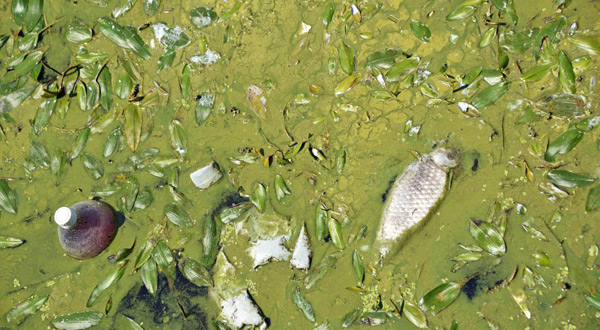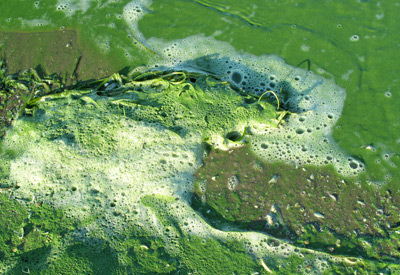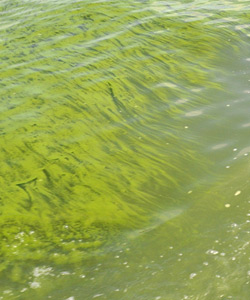If you’ve been watching the news lately, you may have heard about the massive Microcystis algae outbreak that is currently affecting the western basin of Lake Erie and, from this past Friday until around 9:30 this morning, rendered the tap water in Toledo, Ohio and many surrounding communities unsafe to drink. Toledo just happens to be home to yours truly, and “Caribbean Chris” just happens to live in one of those surrounding communities.
My wife and I first learned of this most unusual water emergency at the tail end of our vacation in Florida. Our teenage son and daughter, who are now way too old and cool to travel with Mom and Dad, broke the news via text message. My first thought was, “Thank heaven we’ve stockpiled plenty of clean drinking water that the kids can use (I guess you could say we’re preppers of a sort—though not the wild-eyed, catapult-building, planning-for-Armageddon type). My second thought was, “Hmm, I wonder what this means for my aquariums.” The same question occurred to Chris.
So many questions, so few answers
Is microcystin (the toxin produced by Microcystis) harmful to marine fish and/or invertebrates? We really don’t know. Can the toxin be removed from tap water before using it for water changes or top offs? News reports indicated that microcystin cannot be removed by filtration, but does that apply to the multi-stage reverse-osmosis/deionization units popular with reefkeepers or just your basic carbon filters or mechanical filters? We can’t say. If the toxin does make it into an aquarium, will a good protein skimmer pull it out? Again, we don’t know for sure.
Update: We reached out to Saltwater Smarts contributor, Jay Hemdal, for his thoughts on the situation. He followed up with the photo and statement below.

My speculation is that marine fish and invertebrates would be more sensitive to the microcystin in the water than freshwater fishes — because marine fish need to drink continuously to maintain osmotic balance, and freshwater fish do not. That is borne out in part by the fish out in the lake — they are not usually killed outright by the microcystin, but rather, they tend to move out of those algae areas due to low dissolved oxygen areas at night.
I don’t know if protein skimmers will remove appreciable amounts of toxins, but I tend to doubt it, as they are best at removing particulate organic carbon, and larger organic molecules. My understanding is that microcystin is a peptide.
Carbon filtration, ozone and high chlorine levels seem to work. Authorities have not really been recommending RO, probably because they are thinking of household drinking units. RO/DI with carbon filtration seems to be workable, according to some things I read (CDC?).
It pays to prep
Though this bizarre episode has left me and Chris with more questions than answers, what it has shown us is that when it comes to marine aquarium keeping, it pays to be a bit of a prepper. While the local water restrictions were in place and my wife and I were still out of town, I was able to advise my kids to top off the tanks with stored drinking water rather than take a chance by using water that possibly contained a hazardous toxin. Sure, bottled water may not be as pure as the RO/DI-treated stuff, but it presented a very workable short-term solution.
The day the earth shook
This recent water emergency brought to mind another unusual event that occurred back in 2008 and could have had disastrous consequences for my aquariums. Despite the fact that Ohio isn’t exactly what you’d call an earthquake-prone state, my wife and I were rudely awakened early one morning by a tremor that rattled the windows and violently shook the bed for several seconds. The 5.4-magnitude quake’s epicenter was actually near West Salem, Illinois, but it was felt in several Ohio and Kentucky cities as well.
When the shaking stopped, visions of my two aquariums shattering and collectively dumping 200 gallons of salt water onto the floor downstairs filled my head. Gratefully, both tanks were still completely intact (though the fish looked a little freaked out), but if the shaking had gone on a bit longer, who’s to say what the consequences would have been? How much of that kind of abuse can a glass aquarium withstand?
As I mentioned, earthquakes just aren’t something Toledoans plan for. With the exception of a few almost imperceptible tremors over my almost 46 years of living here, the 2008 Illinois quake was the only noteworthy one I’ve ever experienced. I certainly had never even considered “quake proofing” any of my aquariums—however one would even do that.
What’s your craziest contingency?
Have either of these two situations reminded you of similar unanticipated events that caused problems for your aquariums? If so, let us know in the comment section below. And if any salties out there have insights on how to deal with microcystin, we’d love to hear from you too!




